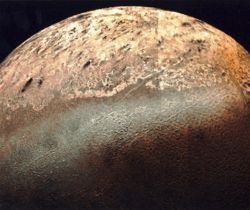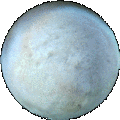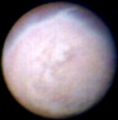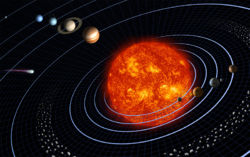Triton
 From Conservapedia
From Conservapedia | Triton | |
|---|---|
 True-color image of Triton's south pole, by Voyager 2 | |
| Date of discovery | October 10, 1846[1] |
| Name of discoverer | William Lassell[1][2] |
| Name origin | Demigod and son of Poseidon and Amphitrite.[1] |
| Orbital characteristics | |
| Primary | Neptune |
| Order from primary | 7 |
| Periposeidion | 354,754 km[3] |
| Apoposeidion | 354,766 km[3] |
| Semi-major axis | 354,760 km[4] |
| Orbital eccentricity | 0.000016[4] |
| Sidereal month | |
| Inclination | 157.345°[4] to Neptune's equator |
| Rotational characteristics | |
| Sidereal day | -5.876854 da[4] |
| Axial tilt | 0° |
| Physical characteristics | |
| Mass | 2.14 * 1022 kg[4] |
| Density | 2,050 kg/m³[4] |
| Mean radius | 1,353.4 km[4] |
| Surface gravity | 0.77955 m/s²[3] |
| Escape speed | 1.4526 km/s[3] |
| Surface area | 23,017,715 km²[3] |
| Mean temperature | 34.5 K[5] |
| Composition | 25% water ice, 75% rock[5] |
| Color | Pinkish-white |
| Albedo | 0.76[4] |
Contents
- 1 Discovery
- 2 Orbital characteristics
- 3 Rotational characteristics
- 4 Physical characteristics
- 5 Theories of origin
- 6 Gallery
- 7 References
- 8 See also
Discovery[edit]
The British astronomer William Laskell discovered Triton on October 10, 1846, less than one month following the discovery of Neptune itself.[2][5] Laskell observed what he at first took to be a ring, but which later proved to be an artifact of the distortion that his new telescope produced. However, Laskell also observed a large satellite, and that image was not due to distortion.[6]
Triton is named after a demigod of the sea, son of Poseidon and his lover Amphitrite. The French astronomer Camille Flammarion is credited with suggesting this name.[1] For more than a century, Triton was the only satellite of Neptune known to man.
Orbital characteristics[edit]
The most remarkable characteristic of this object is its retrograde motion.[2][5] Triton takes 5.876854 Julian days to complete one orbit about Neptune—in a direction opposite to Neptune's own rotation.[4] This makes Triton unique among moons large enough for their self-gravity to force them into hydrostatic-equilibrium (that is, spheroidal) shape. Yet Triton's orbit is nearly circular; its eccentricity is the least of those of the thirteen satellites of Neptune and one of the lowest of the orbital eccentricities of all solar system objects.[4]
Rotational characteristics[edit]
Triton is tidally locked and thus always keeps the same face toward Neptune. Thus its sidereal month and day are the same length, and furthermore its sidereal day is also retrograde.
Physical characteristics[edit]
Triton's mass is 2.14 * 1022 kg, more than 29% that of Earth's Moon and the seventh-largest mass of all the moons in the solar system. With a density of 2,050 kg/m³, it has far more rock and far less water ice than the core of Neptune.[5]
Triton is also the coldest object on record in the solar system, with a mean temperature of only 34.5 kelvins. This is probably due to Triton's unusually high geometric albedo, which causes it to reflect away energy from the Sun that it might otherwise absorb as heat.[5] Yet in the decade since Voyager 2's flyby of Triton in 1989, Triton's trace atmosphere thickened, and its mean temperature rose by two to three kelvins, a radical proportional warming. This was probably due to Triton's unusual orbital inclination, and the exposure of its south pole to more solar radiation than usual.[7]
Triton's surface is considered relatively young, not more than 10 million years by uniformitarian models.[8] Geologists count 100 impact craters on the leading hemisphere (the one facing in the direction of its motion around Neptune) and suspect that debris from collisions involving the inner or outer moons of Neptune have struck Triton on this leading surface.
Triton has many deep chasms on its surface. In addition, Voyager 2 recorded multiple geyser-like eruptions of nitrogen gas and dust from beneath the surface. This gas has created a very low-pressure "atmosphere" that is the only atmosphere-like feature of any solar system body other than earth to have nitrogen as its principle component.[2]
The trailing hemisphere of Triton has a puckered surface with few, widely spaced ridges and valleys and far fewer impact craters. This "cantaloupe terrain" has not been observed on any other celestial body.[9]
Theories of origin[edit]
Triton's retrograde orbit continues to puzzle secular astronomers. Virtually none of them believe that Triton formed at the same time as did Neptune; the nebula hypothesis simply would not allow that. The general consensus, therefore, is that Triton is a captured trans-Neptunian object and possibly a Kuiper Belt object.[2][5][10] Some authorities suggest that the capture and its aftermath might have melted Triton's interior and caused it to differentiate.[2][5][11]
But how that capture might have occurred remains an open question. The two favorite theories are:
- Triton collided with another object, the remains of which persist today as part of Neptune's ring system.[5] The primary difficulty with that theory, as opposed to any other capture theory, is the question of what exactly became of the remains of any object large enough to slow Triton down to enable Neptune to capture it. Neptune's ring system would not appear to have nearly enough matter to account for the destruction of such an object.
- Triton was originally part of a binary or near-binary system, similar to the system of Pluto and Charon, and Neptune separated Triton from its former companion as it passed.[10][12][13][14] However, Agnor and Hamilton, the proponents of this three-body capture model, make no attempt to identify Triton's former companion, if it had one. As a further complication, Triton itself is larger than any other Kuiper belt object except the dwarf planet Pluto. Pluto's orbit is, of course, so eccentric that its periapsis is less than Neptune's apoapsis, so that occasionally Pluto's orbit carries it closer to the Sun than is Neptune. But as one commentator observed,
| “ | The unusual nature of Triton's orbit, the similarity of bulk properties between Pluto and Triton, and the highly eccentric, Neptune-crossing nature of Pluto's orbit suggest some historical connection between them. Exactly what this might be is purely conjecture at this time however.[5] | ” |
A further problem for any capture theory is that Triton's orbit, though retrograde, is almost perfectly circular. Immediately following capture, Triton's orbit would necessarily have been highly eccentric. Ćuk and Gladman admit that tidal deceleration alone would have taken longer than the supposed age of the solar system (i.e. longer than 4.5 billion years) for the orbit to become so circular. Therefore, some other mechanisms must have acted to produce the observed outcome. Ćuk and Gladman propose repeated collisions with other satellites and the absorption of the resulting debris by Triton.[15]
Triton's retrograde orbit does suggest a theoretical "doom" for Triton. With every orbit, tidal forces slow Triton by a tiny amount. At the present rate, secular astronomers estimate that in 1.4 or 3.6 billion years, Triton will pass within Neptune's Roche limit and disintegrate.[16]
Gallery[edit]

Triton

Triton by Voyager 2
References[edit]
- ↑ 1.0 1.1 1.2 1.3 "Gazetteer of Planetary Nomenclature: Planetary Body Names and Discoverers." US Geological Survey, Jennifer Blue, ed. March 31, 2008. Accessed May 9, 2008.
- ↑ 2.0 2.1 2.2 2.3 2.4 2.5 Hamilton, Calvin J. "Entry for Triton." Views of the Solar System, 1997. Accessed May 9, 2008.
- ↑ 3.0 3.1 3.2 3.3 3.4 Calculated
- ↑ 4.00 4.01 4.02 4.03 4.04 4.05 4.06 4.07 4.08 4.09 4.10 Neptunian Satellite Fact Sheet, NASA, January 22, 2008. Accessed May 9, 2008.
- ↑ 5.0 5.1 5.2 5.3 5.4 5.5 5.6 5.7 5.8 5.9 Arnett, Bill. "Entry for Triton." The
Nine8 Planets, October 13, 1998. Accessed May 9, 2008. - ↑ "Triton: Neptune's Largest Moon." Astronomy Picture of the Day, NASA, November 23, 1997. Accessed May 9, 2007.
- ↑ "MIT researcher finds evidence of global warming on Neptune's largest moon," Massachusetts Institute of Technology, June 24, 1998. Accessed May 9, 2008.
- ↑ Schenk, Paul M., and Zahnle, Kevin. "On the Negligible Surface Age of Triton." Icarus, 192(1):135-149, December 1, 2007. <doi:10.1016/j.icarus.2007.07.004 > Accessed May 9, 2008.
- ↑ "Neptune's Moon Triton." The Planetary Society. Accessed May 10, 2008.
- ↑ 10.0 10.1 Goudarzi, Sara. "Neptune Might Have Captured Triton." <http://www.space.com/>, May 10, 2006. Accessed May 10, 2008.
- ↑ "Entry for Triton." The Internet Encyclopedia of Science. Accessed May 10, 2008.
- ↑ Clark, Stuart. "How Neptune snagged a passing moon." New Scientist, 2551:8, May 10, 2006. Accessed May 10, 2008.
- ↑ Stephens, Tim. "New capture scenario explains origin of Neptune's oddball moon Triton." UC Santa Cruz Currents, May 15, 2006. Accessed May 10, 2008.
- ↑ Agnor, Craig B., and Hamilton, Douglas. "Neptune's capture of its moon Triton in a binary–planet gravitational encounter." Nature, 441:192-194, May 11, 2006. <doi:10.1038/nature04792> Accessed: May 10, 2008.
- ↑ Ćuk, Matija, and Gladman, Brett. J. "Constraints on the Orbital Evolution of Triton." Astrophys. J. 626(2):L113-L116, June 2005. Accessed May 10, 2008.
- ↑ Chyba, C. F.; Jankowski, D. G.; Nicholson, P. D. "Tidal evolution in the Neptune-Triton system." Astronomy and Astrophysics, 219(1-2):L23-L26, July 1989. Accessed May 10, 2008.
See also[edit]
John Gribbin, Companion to the Cosmos (Little, Brown & Company, 1996)
| |||||||||||||||||||||||||||||
↧ Download as ZWI file | Last modified: 02/21/2023 15:39:10 | 27 views
☰ Source: https://www.conservapedia.com/Triton | License: CC BY-SA 3.0
 ZWI signed:
ZWI signed:
 KSF
KSF